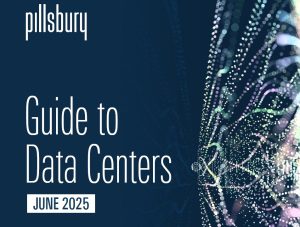On September 8, 2025, the U.S. Department of Energy (DOE) issued a Request for Applications (RFA) seeking proposals from U.S. companies to develop AI data centers co-located with advanced energy projects at the Idaho National Laboratory. This RFA follows the Administration’s July Executive Order on accelerating AI data center infrastructure and DOE’s designation of four federal sites for such projects. At the Idaho National Laboratory, DOE is specifically looking for proposals to potentially enter into long-term leasing agreements at the site. Applications that integrate innovative energy generation and storage with AI data centers will receive priority consideration, including technologies such as advanced nuclear reactors, enhanced geothermal systems, and cold underground thermal energy storage.
Articles Posted in Data Centers
Satellite Data Centers
How did the “final frontier” become a genuine consideration for siting and constructing next-generation data centers? Perhaps it is the inevitable result of demand greatly outstripping supply in two of the great pillars of the data center ecosystem: real estate and power supply. As Pillsbury recently reported in the Pillsbury Guide to Data Centers, some 11,800 data centers were reported to already be operating worldwide in 2024. Yet the demand for centers is expected to rise by as much as 22% annually until 2030, placing significant constraints on the ability of operators to locate sufficient real estate to build and operate them all, obtain the necessary permits for construction and operation on a timely basis, and, significantly, ensure the availability and reliability of electricity to power and cool the components. Or perhaps growing concerns over security, resiliency and environmental impacts are driving operators and users to look for alternative solutions.
Pillsbury’s Guide to Data Centers
 Pillsbury’s experience with data centers dates to the dot-com era. Since then, we’ve counseled the industry as proprietary centers were supplemented, and in some cases supplanted, by physical and cloud-based systems of larger dedicated enterprises. The data center landscape is now international in scope and diverse in speciation, with edge, modular, enterprise and hyperscale facilities each playing important yet distinctive roles, and just as there is no single locus of data center expertise in legal practice, there is no single locus of capabilities and users in the business environment. Pillsbury’s Data Centers team accordingly deploys a one-stop, hub-and-spoke model that reflects the complex ecosystem in which these localized points of computation sit. In an effort to gather these nodes of knowledge and experience into a distinctive publication, the Pillsbury Guide to Data Centers brings together a curated selection of articles which reflects the experience of our firm’s interdisciplinary team in advising clients on the development, acquisition, financing, construction and operation of data centers across the U.S. and internationally. These articles are intended to be enduring reference pieces that lawyers and clients of all levels of sophistication may wish to keep handy as they encounter questions and challenges in this field.
Pillsbury’s experience with data centers dates to the dot-com era. Since then, we’ve counseled the industry as proprietary centers were supplemented, and in some cases supplanted, by physical and cloud-based systems of larger dedicated enterprises. The data center landscape is now international in scope and diverse in speciation, with edge, modular, enterprise and hyperscale facilities each playing important yet distinctive roles, and just as there is no single locus of data center expertise in legal practice, there is no single locus of capabilities and users in the business environment. Pillsbury’s Data Centers team accordingly deploys a one-stop, hub-and-spoke model that reflects the complex ecosystem in which these localized points of computation sit. In an effort to gather these nodes of knowledge and experience into a distinctive publication, the Pillsbury Guide to Data Centers brings together a curated selection of articles which reflects the experience of our firm’s interdisciplinary team in advising clients on the development, acquisition, financing, construction and operation of data centers across the U.S. and internationally. These articles are intended to be enduring reference pieces that lawyers and clients of all levels of sophistication may wish to keep handy as they encounter questions and challenges in this field.
Investing in Data Centers
It seems like such a simple question. Who owns data centers?
Ownership structures in the digital economy are more varied than might appear on the surface. While the largest computing and cloud service providers, such as Apple, Amazon (AWS), Microsoft (Azure) and Google (Cloud)—also known as “hyperscalers”—do own and operate a significant portion of their global infrastructure, they are increasingly partnering with third-party developers and investors, including real estate investment trusts (REITs), to expand capacity and deploy capital quickly and efficiently. This article provides a guide to how the most prominent strategic and financial players are engaging in this sector.
Powering Data Centers with Nuclear Generation
The rapid growth of electricity demand from data centers has emerged as a major challenge for the U.S. power sector. Much of this demand is being driven by the deployment of large learning models (LLMs) and generative artificial intelligence (AI). These workloads require large-volume, high-uptime computational infrastructure, and correspondingly large, reliable power supplies.
PFAS, HFCs and Related Chemicals in the Data Center Industry
Data centers use various chemicals that have recently been the focus of regulatory efforts at the federal and state level. The historic or future use of these chemicals may create liabilities, obligations, or new costs for both existing and planned data centers.
Designing, Constructing and Converting Data Centers and Crypto Mines
 The ever-increasing demand for digital infrastructure, coupled with continuing cryptocurrency demand volatility, has generated significant interest in transforming building improvements housing crypto mining farms into modern high-capacity data centers. Crypto mines and data centers share certain foundational elements—facilities with a large footprint and the need for high power capacity and cooling—but they have different functions, and their operational models, technical requirements and regulatory considerations are correspondingly diverse. Below are some key distinctions between the two, as well as issues developers should anticipate, when designing and constructing either type of facility, or considering a crypto farm-to-data center conversion.
The ever-increasing demand for digital infrastructure, coupled with continuing cryptocurrency demand volatility, has generated significant interest in transforming building improvements housing crypto mining farms into modern high-capacity data centers. Crypto mines and data centers share certain foundational elements—facilities with a large footprint and the need for high power capacity and cooling—but they have different functions, and their operational models, technical requirements and regulatory considerations are correspondingly diverse. Below are some key distinctions between the two, as well as issues developers should anticipate, when designing and constructing either type of facility, or considering a crypto farm-to-data center conversion.
U.S. Department of Energy Pursues Data Centers on Federal Lands
On April 7, the Office of Policy for U.S. Department of Energy (DOE) published a Request for Information (RFI) seeking input from industry professionals, grid operators, local communities, Tribal governments, and other stakeholders regarding the development and operation of AI infrastructure—including data centers—on DOE-owned or managed lands. This initiative aligns with the January 2025 Executive Order, Removing Barriers to American Leadership in Artificial Intelligence, which underscores AI as a national and economic security priority. DOE is hoping the RFI provides information that allows it to better understand site interest, strategic data center design approaches, potential power needs, financial and contractual considerations related to leasing DOE-owned or managed lands, and the potential benefits and challenges associated with hosting AI infrastructure on DOE land.
Data Centers: A Field Guide
By one count, worldwide there were some 11,800 data centers in early 2024. Within that census are facilities so small that they fit in office building closets, while others are among the largest manmade structures on the planet. How are we to make sense of this diverse population?
Data centers house servers, storage devices and network devices to store, process and disseminate large quantities of data of organizations and their customers and supply chains. The size and complexity of these facilities vary with their functions in the business ecosystem. Much like the well-known depictions of the evolution of horses from tiny brush creatures to mighty stallions, the overall category cries out to be broken down along multiple dimensions.
This post provides a naturalist’s field guide to data center types and features.
Apple’s $500B U.S. Manufacturing Push and New AI Server Facility in Houston: What It Means for Data Centers
As we covered previously, President Trump has made clear that the U.S. is focused on increasing investments into building, scaling and speeding the development of AI infrastructure and data centers in the U.S., and Big Tech is responding in kind.
 Gravel2Gavel Construction & Real Estate Law Blog
Gravel2Gavel Construction & Real Estate Law Blog



